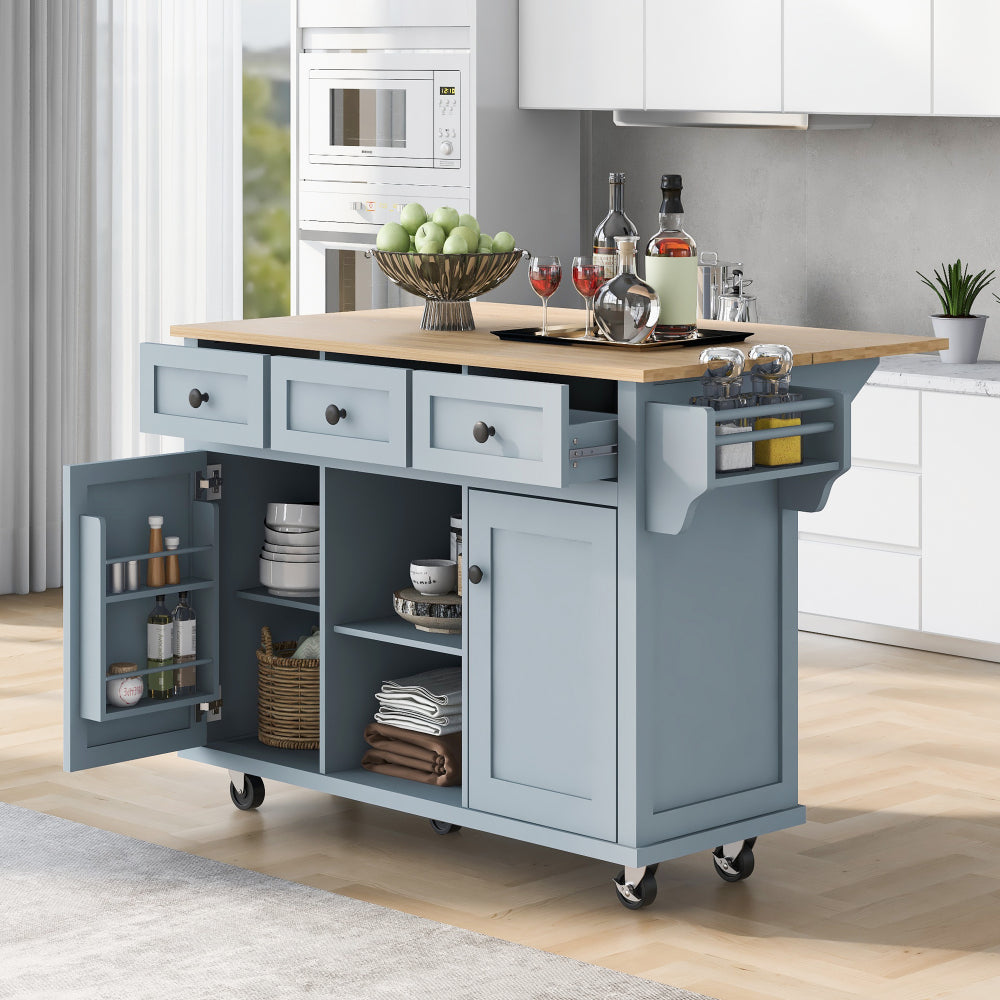
How to Use a Kitchen Island to Increase Prep Space and Seating
Share
How to Use a Kitchen Island to Increase Prep Space and Seating
Do you dream of a kitchen with more room to chop, mix, and mingle? Many homeowners face the challenge of limited counter space, making cooking a tight squeeze, or lack a casual spot for family and friends to gather. A kitchen island is often the perfect solution, transforming your kitchen's functionality and feel.
Here are some common questions you might have:
-
Q: My kitchen isn't huge. Can I still fit an island?
A: Absolutely! Islands come in various sizes. A rolling kitchen island, like the TimberFalre 53.1″ Rolling Kitchen Island with Rubberwood Drop-Leaf Countertop, is designed to provide extra space when you need it, solving the problem of limited permanent counter area without taking up fixed floor space. -
Q: How do islands add seating?
A: Many islands feature a countertop overhang, creating a comfortable space to pull up bar stools or chairs. This turns the island into an informal dining or gathering spot. -
Q: Are islands hard to integrate into an existing kitchen?
A: Mobile islands are easy to add. Built-in islands require more planning but can be seamlessly integrated into many layouts with the right design and professional help.
A kitchen island can revolutionize your kitchen, offering essential workspace, convenient seating, and valuable storage. This guide explores how to choose and use a kitchen island to maximize both your prep area and your home's social hub.
1. Understanding the Need for More Space
1.1 The Challenge of Limited Prep Area
Insufficient counter space is a primary pain point in many kitchens. It makes meal preparation feel cramped and inefficient. Juggling cutting boards, appliances, and ingredients on limited surfaces is frustrating and can even make cooking less enjoyable. Expanding your usable prep area is key to a more functional kitchen.
1.2 The Desire for Casual Seating
Kitchens are natural gathering places. Without dedicated seating, guests or family members may crowd the workspace. Adding seating to your island creates a comfortable spot for quick meals, homework, or simply keeping the cook company, fostering connection in the heart of the home.
2. The Kitchen Island Solution: Types and Benefits
2.1 More Than Just a Surface
A kitchen island adds significant counter space, but its benefits extend far beyond that. It can centralize tasks, improve workflow, and provide crucial storage. Islands act as a flexible hub, adapting to different needs like food prep, casual dining, or serving during gatherings.
2.2 Choosing Your Island Type
Kitchen islands come in several forms:
- Built-in Islands: Permanent, often matching cabinetry. Offer maximum customization, storage, and potential for integrated appliances (sinks, cooktops). A large kitchen island is typically built-in.
- Mobile/Rolling Islands: Feature wheels for portability. Ideal for smaller kitchens or those needing flexible space. A rolling kitchen island is easy to move wherever extra surface or seating is needed.
- Cart-Style Islands: Smaller, simpler mobile units, often with open shelving.
- Table-Style Islands: Counter-height tables offering ample surface and legroom for seating, with less built-in storage.
Selecting the right type depends on your kitchen size, layout, and primary needs.
3. Designing for Prep Space and Seating
3.1 Sizing and Placement
Proper sizing and placement are crucial. Ensure adequate clearance (36-48 inches recommended) around a fixed island for easy movement and access to cabinets and appliances. For seating, allow about 24 inches width per person and at least 12 inches of countertop overhang for comfortable legroom at counter height (10-11 inches for bar height). The island should enhance, not hinder, your kitchen's workflow and traffic patterns.
3.2 Features for Functionality
Consider features that boost utility:
- Countertop Material: Choose based on durability, maintenance, and style (e.g., butcher block kitchen island for prep, granite for durability).
- Storage: Drawers, cabinets, open shelves, or specialized pull-outs for trash or recycling.
- Seating Overhang: Essential if you plan to add stools.
- Electrical Outlets: Convenient for using small appliances.
- Drop-Leaf: Provides expandable surface area and seating options, great for smaller spaces or flexible use.
| Island Type | Key Benefits | Space Considerations | Material Examples | Design Vibe |
|---|---|---|---|---|
| Built-in | Permanent space, extensive storage, appliance integration. | Requires significant fixed floor space & clearance (36-48"). | Granite, Quartz, Butcher Block, Wood/MDF base. | Integrated, Focal Point, Customizable. |
| Mobile/Rolling | Flexible space, portability, temporary seating/prep. (e.g., TimberFalre Rolling Island) | Best for smaller kitchens; can be moved/tucked away. | Butcher Block, Stainless Steel, Laminate, Rubberwood, Wood/Metal base. | Adaptable, Practical, Casual. |
| Table-Style | Great for seating, large surface, open feel. | Requires good legroom clearance; less base storage. | Wood, Butcher Block, Stone top. | Communal, Informal Dining, Open. |
4. Materials, Style, and Integration
4.1 Choosing Materials
Countertop material impacts both function and style. A butcher block kitchen island provides a warm, prep-friendly surface. Granite or quartz offer durability and low maintenance. Stainless steel is hygienic and modern. Consider how you'll use the surface and the desired aesthetic.
4.2 Styling Your Island
Your island can match existing cabinetry for a seamless look or feature contrasting colors/materials to stand out. A rustic kitchen island can add character. Accessorize with lighting (pendants are popular), stools, and decorative items to reflect your personal style and make the island inviting.
5. Featured Solution: The TimberFalre Rolling Island
5.1 Flexibility for Modern Kitchens
The TimberFalre 53.1″ Rolling Kitchen Island with Rubberwood Drop-Leaf Countertop is an excellent example of a versatile solution. Its rolling design allows you to easily move extra prep space or temporary seating wherever needed. The drop-leaf countertop provides a generous work surface when extended, folding down to save space, making it ideal for smaller or multi-functional kitchen areas.
6. Advanced Tips for Island Living
6.1 Incorporate Lighting and Power
Dedicated task lighting over the island is essential for prep work. Pendant lights are a stylish and functional choice. Adding electrical outlets or USB ports makes using small appliances and charging devices incredibly convenient on the island.
6.2 Think Beyond the Kitchen
For large spaces or specific needs, consider a dedicated outdoor kitchen island for entertaining or cooking al fresco. For internal islands, remember their potential as a family command center, homework station, or craft area, enhancing their value beyond just cooking.

53'' Outdoor Kitchen Island Drop Leaf with Storage
Key Features Weather-Resistant Construction: Built with a powder-coated steel frame, poly wood top, and wicker exterior for lasting durability indoors...
6.3 Maintenance Matters
Proper care for your island's materials is key to its longevity. Butcher block needs regular oiling, while stone may need sealing. Keep the base clean and check rolling casters if applicable. Addressing small issues promptly keeps your island looking and functioning its best.
